Managing paid time off (PTO) has become an essential part of every business, helping to maintain employee satisfaction and comply with legal requirements. With the rise of PTO Mobile Apps, managing time off is now easier than ever, allowing both employers and employees to track leave requests, approvals, and balances from anywhere. In this article, we’ll explore the top 10 PTO mobile apps that simplify Day Off management for businesses of all sizes.
Day Off Vacation Tracker
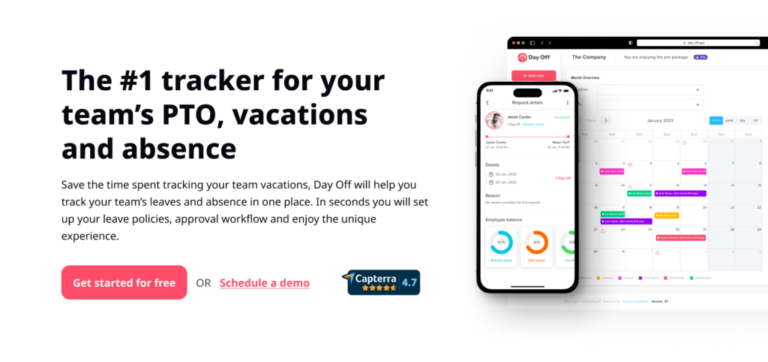
Key Features
- Simple PTO Tracking: Allows easy management of paid time off (PTO) for employees.
- Automated Leave Requests: Facilitates online leave requests and approvals.
- Customizable Leave Policies: Supports setting up different leave policies for various employee groups.
- Accrual Management: Tracks leave accruals and balances automatically.
- Multi-Device Access: Available on both mobile and desktop devices for easy access.
- Employee Self-Service: Allows employees to track their leave balance, apply for leave, and check their approval status.
- Team Calendar: Displays a shared calendar showing who is on leave within the team or department.
- Integration with HR Systems: Easily integrates with existing HR software for seamless data synchronization.
- Notifications and Reminders: Sends email or app notifications for upcoming leave or approval requests.
- Role-Based Access Control: Administrators can assign different levels of access to managers, employees, and HR staff.
Workflow
HR Dashboard
best price
$1 Employee / Month • Trial: Yes • Free Plan: Yes.
Pros
User-Friendly Interface: The app is designed to be intuitive and easy to navigate.
Customizable: Flexible leave policies tailored to different companies or teams.
Efficient Leave Management: Reduces paperwork and automates the leave approval process.
Visibility: Managers can see a comprehensive view of the team’s leave schedule, helping in planning.
Mobile Access: Employees can request and view leave from anywhere using their mobile devices.
Leave Balance Tracking: Employees can check their remaining leave balances at any time.
Boosts Employee Satisfaction: Transparency in leave management enhances employee trust.
Cons
Limited Offline Access: Requires internet connectivity to access features and data.
Scaling for Larger Organizations: May not be as robust for managing very large teams with complex leave structures.
BambooHR
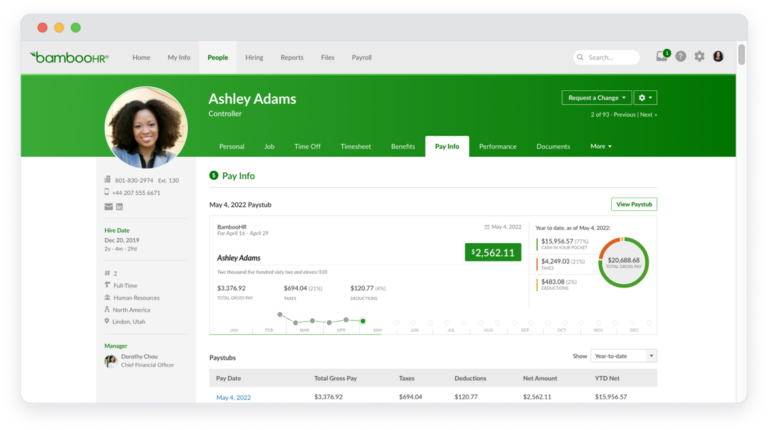
Key Features
- Employee Self-Service: Allows employees to access their personal information, request time off, and update details without needing HR intervention.
- Applicant Tracking System (ATS): Helps manage the entire hiring process, from job postings to candidate tracking and onboarding.
- Time-Off Tracking: Automates PTO requests, approvals, and balances, making leave management simpler.
- HR Reporting and Analytics: Provides customizable reports on key HR metrics, such as turnover, time-off usage, and employee demographics.
- Employee Database: Centralizes all employee information in one place, including personal details, job history, and performance records.
- Performance Management: Offers tools for setting goals, conducting reviews, and managing employee performance.
- Document Storage: Stores employee documents in a secure and organized digital format, making it easy to manage employee files.
- Onboarding and Offboarding: Automates the process of bringing new employees into the system and offboarding departing employees.
- Mobile App: Provides access to key features, such as time-off requests and personal data, through a mobile app.
- Integration with Payroll Systems: BambooHR integrates with popular payroll systems, enabling seamless payroll processing.
Workflow
HR Dashboard
$5 to $10 per employee per month • Trial: Yes • Free Plan: No.
Pros
User-Friendly Interface: The platform is easy to navigate, even for non-technical users.
Centralized Employee Data: Helps HR teams store all employee-related information in a single, easily accessible location.
Time-Off Management: Streamlined PTO tracking and automated balance updates make leave management hassle-free.
Customizable Reports: Offers flexibility in reporting, allowing users to generate specific HR reports tailored to their needs.
Scalable for Growing Businesses: Ideal for small to mid-sized companies, with features that grow with the business.
Mobile Access: Employees and managers can access the system on the go, improving accessibility and productivity.
Effective Onboarding Process: The onboarding feature ensures new hires have a smooth transition into the company.
Integration with Payroll and Other Tools: Easy integration with payroll and other HR tools ensures smooth operations.
Applicant Tracking and Hiring Features: The ATS simplifies hiring and helps manage candidates throughout the recruitment process.
Document Management: Secure document storage eliminates the need for paper-based filing systems.
Cons
Limited Payroll Features: BambooHR lacks built-in payroll processing, requiring integrations with third-party payroll services.
No Customization for Performance Reviews: Some users report that the performance review templates are not highly customizable.
Higher Cost for Small Businesses: While affordable for mid-sized companies, it may be expensive for very small businesses or startups.
Limited Advanced HR Features: Lacks some advanced HR functionalities like predictive analytics and in-depth compliance tracking.
Basic Mobile App: The mobile app is somewhat limited in functionality compared to the web version, offering fewer features.
Slow Customer Support: Some users report that customer support can be slow to respond to issues or requests.
Complex Initial Setup: The initial implementation process can be complex and may require some time to fully configure for the company’s needs.
Limited Global Support: BambooHR is primarily focused on the U.S. market and may not offer extensive support for international companies.
No Native Time Tracking: While it offers time-off tracking, BambooHR does not include a full-featured time tracking system.
Price Increases with Growth: As the company grows and requires additional features, the pricing structure may become more expensive.
Zenefits
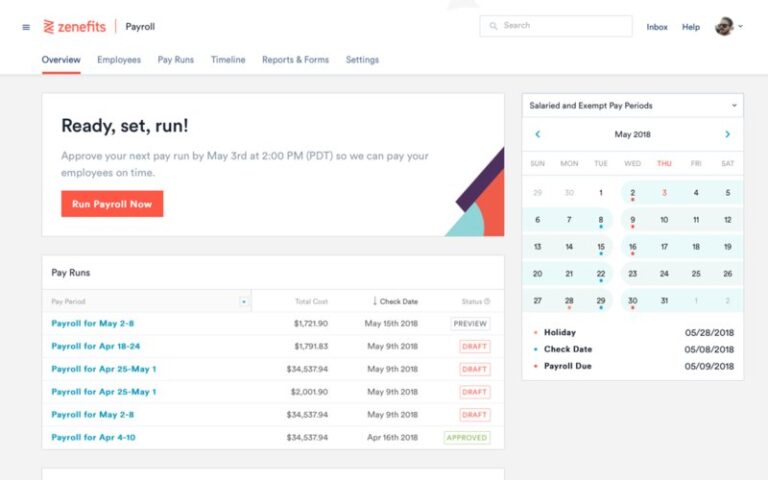
Key Features
- Payroll Processing: Zenefits offers seamless payroll processing, handling employee and contractor payments, tax calculations, and filings.
- Benefits Management: Manages health insurance, retirement plans, and other employee benefits, with easy integration into payroll.
- HR Tools: Provides features like employee onboarding, performance management, compliance tracking, and document management.
- Time and Attendance: Tracks employee hours, PTO, and overtime, with features for scheduling and automatic sync with payroll.
- Employee Self-Service: Employees can access pay stubs, tax documents, benefits information, and update personal details through an intuitive self-service portal.
- Compliance Management: Helps businesses stay compliant with labor laws, ACA reporting, and tax regulations through automatic updates and notifications.
- Mobile App: Offers full access to payroll, benefits, and HR tools on mobile devices, allowing both employers and employees to manage tasks on the go.
- Integrations: Zenefits integrates with popular business tools like QuickBooks, Slack, Salesforce, and other payroll and accounting systems.
- Wellness Benefits: Offers wellness programs and perks that allow businesses to promote employee health and well-being.
Integrations
Automation
$10 to $27 per employee per month • Trial: No • Free Plan: No.
Pros
All-in-One HR Solution: Zenefits combines payroll, benefits, and HR management in a single platform, making it convenient for small and medium-sized businesses.
Employee Self-Service: Empowering employees to manage their own information reduces the burden on HR staff and improves transparency.
Easy Integration: Integrates seamlessly with other software such as accounting tools, time tracking systems, and business management software.
Comprehensive Benefits Management: Manages a wide range of employee benefits, including health insurance and retirement plans, with easy integration into payroll.
Mobile-Friendly: The mobile app allows businesses to manage HR tasks from anywhere, which is a big plus for remote teams.
Affordable for HR Features: Compared to some other full-service HR platforms, Zenefits offers a relatively affordable option for small to mid-sized businesses.
Compliance Support: Zenefits helps businesses stay compliant with federal, state, and local labor laws, including ACA reporting and tax compliance.
Cons
Payroll as an Add-On: Payroll services are not included in the base plan and require an additional fee, which may increase costs for businesses needing integrated payroll.
Limited Customer Support: Some users report that customer support can be slow or not as helpful as they would expect, especially during critical issues.
Learning Curve: While feature-rich, the platform may have a steeper learning curve for businesses new to HR software, especially when managing multiple features.
Not Ideal for Larger Enterprises: Zenefits is best suited for small to mid-sized businesses and may lack some advanced features or scalability for larger enterprises.
Pricing Increases with Advanced Features: While affordable for basic HR needs, costs can rise quickly when opting for more advanced features like payroll and compliance add-ons.
Gusto
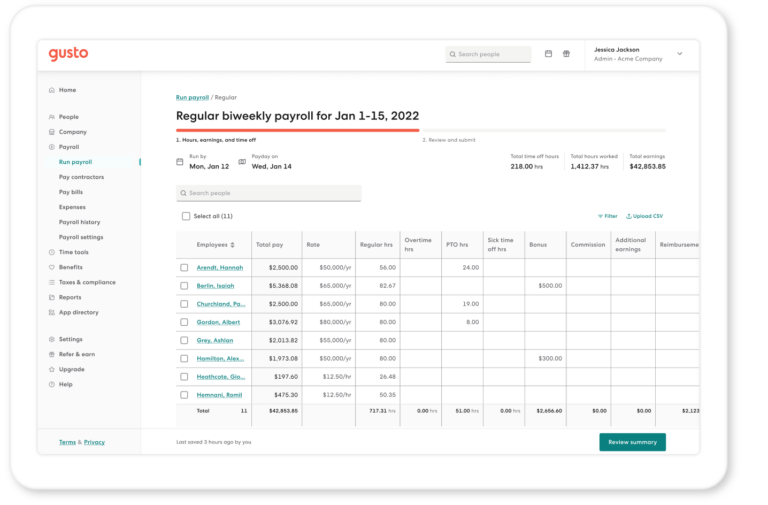
Key Features
- Payroll Processing: Automates payroll calculations, tax filings, and direct deposits for employees. Supports multi-state payroll and automatic tax payments.
- Benefits Management: Offers employee benefits such as health insurance, 401(k) retirement plans, commuter benefits, and more, with integration for easy enrollment and management.
- Time Tracking: Integrated time tracking for employees to clock in/out, sync time with payroll, and manage paid time off (PTO).
- HR Tools: Provides onboarding tools, employee self-service, performance reviews, and employee directories.
- Compliance Assistance: Ensures compliance with federal, state, and local labor laws, including automatic updates for tax law changes.
- Employee Self-Service: Employees can access payslips, tax documents (W-2s, 1099s), and benefits information via the self-service portal.
- Contractor Payments: Supports payments for contractors, with automatic 1099 filings.
- Automated Tax Filing: Handles payroll taxes, including federal, state, and local taxes, and files forms automatically on behalf of the business.
- Mobile-Friendly: Offers mobile access for employees and employers to manage payroll and HR tasks on the go.
- Customizable Reports: Allows businesses to generate customized reports related to payroll, benefits, and taxes for better insights.
Workflow
HR Dashboard
$6 to $12 per employee per month • Trial: Yes • Free Plan: No.
Pros
User-Friendly Interface: Known for its clean and intuitive design, making payroll and HR management simple, even for small business owners without an HR background.
Affordable for Small Businesses: Gusto is cost-effective, particularly for startups and small businesses, offering transparent pricing with no hidden fees.
Comprehensive Payroll and Benefits: Covers both payroll and benefits management in a single platform, reducing the need for multiple systems.
Automated Compliance: Automates tax filings and compliance updates, ensuring that businesses stay up-to-date with federal and state regulations.
Great Customer Support: Offers responsive customer service and detailed guides to help users with setup and ongoing management.
Scalability: Gusto can grow with your business, supporting both W-2 employees and 1099 contractors.
Employee Self-Service: Employees can manage their own data, reducing the burden on HR departments.
Paperless Onboarding: Simplifies onboarding for new employees with digital documents, forms, and direct deposit setup.
Free Health Benefits Setup: Provides free benefits setup, helping businesses offer health insurance and other perks to their employees.
Cons
Limited for Larger Businesses: While perfect for small and mid-sized businesses, it may lack the advanced HR features and customization options required by larger enterprises.
State-Specific Limitations: Certain features, like health insurance and workers’ comp, are only available in specific states, limiting options for businesses in other regions.
Pricing Increases with Features: Gusto’s pricing can become expensive as you add more features, particularly if you require advanced HR tools or support for a larger number of employees.
Limited Customization: Some users report that while Gusto is easy to use, it lacks in-depth customization for more complex payroll and HR needs.
No Mobile App for Employers: Gusto does not offer a dedicated mobile app for employers to run payroll or access other features on the go, although employees can access the platform through their mobile browsers.
Payroll Only Available in the U.S.: Gusto only supports payroll and tax filings within the U.S., so it’s not suitable for businesses with global payroll needs.
ADP Mobile Solutions
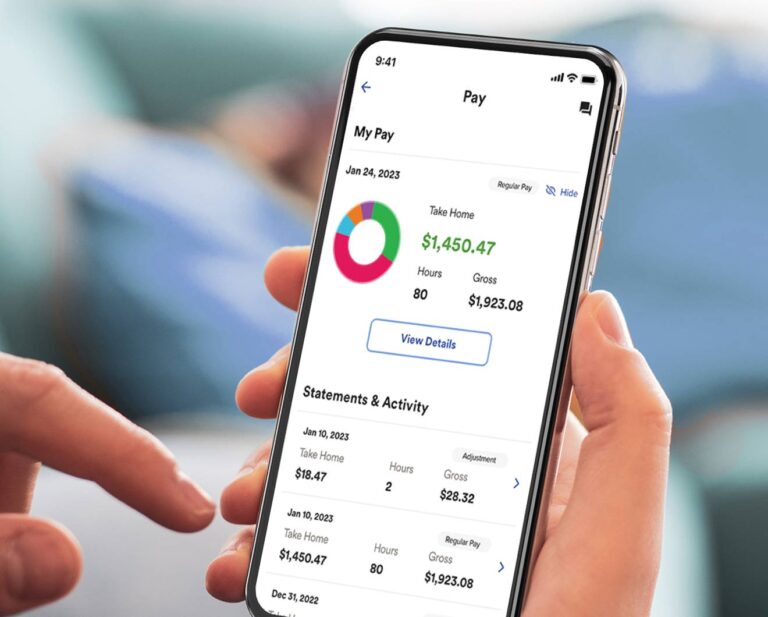
Key Features
- Employee Self-Service: Allows employees to access pay stubs, tax forms, benefits information, and time cards.
- Time and Attendance Tracking: Employees can clock in and out, view schedules, and request time off directly from the app.
- Payroll Management: Employees can access their payroll information, including pay stubs, and view direct deposit details.
- Benefits Administration: Access to benefit plans, enrollments, and updates, helping employees manage healthcare and retirement plans.
- Mobile Access to HR Data: Employees and managers can access personal data, performance evaluations, and manage direct reports through the app.
- Notifications and Alerts: Receive push notifications for important updates like benefits enrollment periods, time off requests, or paycheck deposits.
- Mobile Expense Management: Some versions support tracking and submission of expenses through the app.
- Secure Authentication: Includes biometric authentication, such as fingerprint or facial recognition, for secure login.
Workflow
HR Dashboard
$4-$6 per employee per month • Trial: No • Free Plan: No.
Pros
User-Friendly Interface: The app has a clean, intuitive interface that makes it easy for employees to navigate and manage HR tasks.
Convenient Mobile Access: Provides employees with access to critical payroll, benefits, and time-tracking features anytime, anywhere.
Multi-Device Compatibility: Available on both Android and iOS, offering flexibility across platforms.
Secure: Strong focus on security features like biometrics ensures data privacy.
Integration with ADP Solutions: Seamlessly integrates with other ADP HR and payroll systems, providing a complete solution for businesses.
Real-Time Updates: Instant access to the latest payroll and benefits data.
Cons
Limited Functionality for Managers: While employees have many features, management tools and insights can be limited in the mobile app compared to the desktop version.
Dependence on Internet Connectivity: The app requires a reliable internet connection to access HR data, which can be inconvenient in areas with poor connectivity.
Complexity in Setup: Some users may find the initial setup and integration with other ADP systems to be cumbersome.
Notifications Overload: Some users report receiving too many notifications, which can become distracting.
Limited Customization: The app may not be customizable enough for companies with specific or unique HR needs.
Toggl Plan
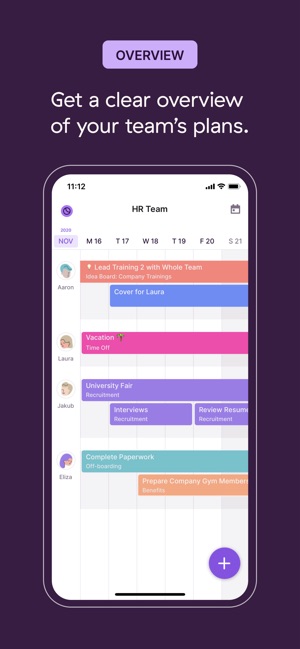
Key Features
- Project Planning & Scheduling: Offers a visual timeline (Gantt-chart style) to help plan and schedule tasks and projects efficiently.
- Drag-and-Drop Interface: Intuitive drag-and-drop feature for creating and adjusting tasks, timelines, and dependencies.
- Team Management: Ability to assign tasks to team members, manage workloads, and track team capacity.
- Task Management: Provides detailed task tracking, with the ability to add due dates, descriptions, subtasks, and dependencies.
- Collaboration Tools: Team members can comment on tasks, upload files, and collaborate directly within the platform.
- Milestones: Ability to set milestones to track key project deliverables and deadlines.
- Multiple Views: Switch between timeline, board (Kanban), and list views depending on your preference.
- Integrations: Seamless integration with tools like Slack, Google Calendar, and Jira for a smooth workflow.
- Mobile App: Access and manage projects and tasks on the go with a mobile app for both iOS and Android.
- Customizable Workflows: Create custom workflows for different types of projects, ensuring flexibility.
$9 to $15 per employee per month • Trial: Yes • Free Plan: Yes.
Pros
Easy to Use: The interface is user-friendly and highly intuitive, making project planning simple, even for beginners.
Flexible Visual Planning: The visual timelines and board views provide clear overviews, allowing for easy project tracking and management.
Team Collaboration: The ability to assign tasks, leave comments, and upload files directly to tasks improves communication and collaboration.
Affordable Pricing: Toggl Plan offers relatively affordable pricing, especially for smaller teams, with a free tier available.
Task Dependencies: Task linking and dependencies help keep the workflow organized and ensure tasks are completed in the correct order.
Multi-View Options: Being able to switch between timeline, board, and list views gives flexibility for how teams prefer to manage tasks.
Real-Time Updates: The real-time collaboration keeps everyone on the same page with automatic updates to plans and tasks.
Good for Small Teams: Perfect for small to medium-sized teams, especially those with lighter project management needs.
Cons
Limited Advanced Features: Lacks some advanced features such as budgeting, time tracking, or resource management, which can be found in more robust project management tools.
Limited Reporting: Reporting features are basic and may not be sufficient for larger or more data-driven projects.
No Native Time Tracking: Unlike other Toggl products (e.g., Toggl Track), Toggl Plan does not have a built-in time tracking feature, requiring users to rely on third-party integrations.
Limited Customization: While it offers basic workflows and views, it may not be as customizable for more complex project needs.
Not Ideal for Large Projects: While great for smaller teams, Toggl Plan may not be sufficient for managing large, multi-phase projects with complex needs.
Offline Access: Limited functionality when offline, as it relies heavily on internet connectivity for updates and collaboration.
Learning Curve for Advanced Use: While easy to use for simple tasks, more complex features like dependencies and team planning may require a bit of a learning curve.
Workday
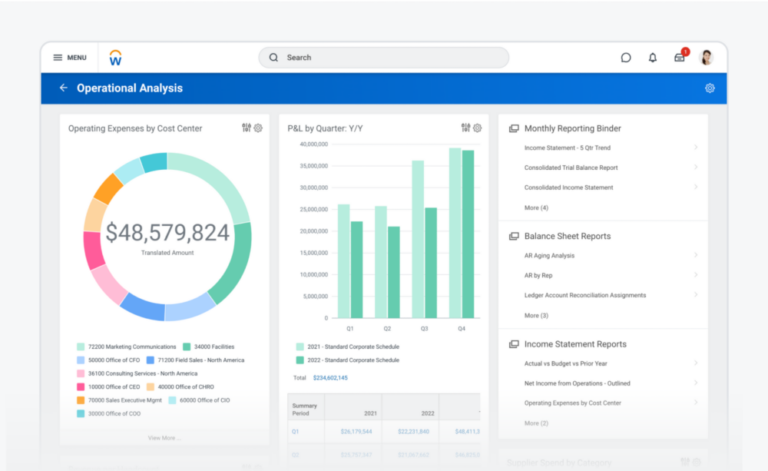
Key Features
- Comprehensive HR and Finance Platform: Provides an all-in-one solution for human resources, payroll, talent management, and finance.
- Employee Self-Service: Allows employees to access their personal data, request time off, manage benefits, and update personal information.
- Talent Management: Includes recruiting, onboarding, performance reviews, and succession planning features.
- Workforce Analytics: Offers real-time analytics and reporting to help with decision-making and tracking key HR metrics.
- Payroll Management: Manages payroll processing, taxes, and compliance across multiple countries.
- Time and Absence Tracking: Tracks employee time, attendance, and leave requests, with customizable time-off policies.
- Integration with Other Systems: Easily integrates with third-party systems such as ERP, CRM, and other HR tools.
- Mobile Access: Offers a mobile app that allows employees and managers to access Workday functions on the go.
- Global Compliance: Supports compliance with regional labor laws and payroll regulations across multiple countries.
- Security and Privacy: Includes enterprise-grade security features, data encryption, and role-based access control.
Workflow
HR Dashboard
$100 to $200 per employee per year • Trial: Yes • Free Plan: No.
Pros
All-in-One Solution: Combines HR, payroll, finance, and talent management into a single platform.
Scalable for Enterprises: Ideal for large businesses with complex needs, offering robust features that can scale across regions and departments.
User-Friendly Interface: Clean and modern design that enhances the user experience for both employees and administrators.
Advanced Analytics and Reporting: Offers deep insights into workforce data with customizable reports and real-time analytics.
Global Compliance Features: Ensures companies remain compliant with regional and international labor laws.
Mobile App for Flexibility: Employees can manage HR tasks and request time off from their mobile devices.
Cloud-Based: No on-premise installation, offering easier updates and lower infrastructure costs.
Continuous Updates: Regular updates and feature improvements with no need for manual upgrades by the user.
Customizable Dashboards: Offers flexibility to tailor dashboards and workflows to the needs of the organization.
Strong Security Features: Provides top-tier data security, including encryption, regular audits, and access controls.
Cons
High Cost: Expensive subscription-based pricing, which may be prohibitive for small to mid-sized businesses.
Complex Implementation: Initial setup and implementation can be lengthy and require significant resources and planning.
Steep Learning Curve: Can be challenging for users unfamiliar with comprehensive HR software, particularly during the transition period.
Customization Limitations: Some customization options are limited or require additional consulting or third-party assistance.
Mobile App Limitations: Although the mobile app provides access to many features, some advanced functionalities may not be fully available or optimized for mobile use.
Overly Complex for Small Businesses: May offer more features than needed for smaller organizations, leading to unnecessary complexity.
Integration Challenges: While integration is possible, it may require additional development resources or third-party tools.
Performance Issues in Large Deployments: Some users report performance lags or slowdowns when managing large volumes of data.
Frequent System Updates: Although updates are beneficial, frequent changes can disrupt workflows if users are not adequately trained or informed.
Limited Flexibility in Custom Reports: Creating highly customized reports may require expert knowledge or external support.
Keka

Key Features
- Payroll Management: Keka provides comprehensive payroll processing that automates salary calculations, tax deductions, compliance (PF, ESI, TDS), and payslip generation.
- Attendance & Leave Management: Features real-time tracking of attendance, integrated with biometric devices, and allows employees to request leave via a self-service portal.
- Expense & Reimbursement Management: Employees can submit expense claims, and managers can approve reimbursements seamlessly.
- HR and Employee Self-Service: Includes employee self-service portals where employees can access payslips, apply for leave, update personal details, and more.
- Recruitment and Onboarding: Streamlines recruitment processes with job postings, candidate tracking, interview scheduling, and a smooth onboarding experience for new hires.
- Performance Management: Enables goal setting, tracking, performance reviews, and feedback mechanisms to support continuous employee development.
- Mobile App: Keka offers a mobile app for employees to access their payroll, attendance, and leave management from anywhere.
- Compliance Management: Automates statutory compliance for Indian labor laws, such as EPF, ESI, PT, and TDS.
- Time Tracking: Provides a detailed breakdown of employee work hours, projects, and productivity insights for accurate billing and management.
- Employee Engagement: Includes tools for employee surveys, feedback, and rewards & recognition systems to improve employee satisfaction.
Workflow
Automation
$100-$150 per month • Trial: Yes • Free Plan: No.
Pros
Comprehensive HR Solution: Keka offers an all-in-one platform for HR management, payroll, and compliance, reducing the need for multiple tools.
User-Friendly Interface: The platform is easy to navigate, both for HR administrators and employees, with a clean, intuitive interface.
Automation: Automated processes like payroll calculations, compliance, and attendance tracking reduce manual errors and save time.
Customizable: Keka is customizable to fit the specific needs of various businesses, allowing for tailored workflows, reports, and policies.
Strong Compliance Management: Ensures businesses adhere to labor law requirements and manage statutory compliances effortlessly, especially useful for Indian businesses.
Mobile Accessibility: The mobile app allows employees to manage their time, attendance, and payroll details on the go, enhancing convenience.
Good Integration: Integrates with biometric attendance devices and other software systems like accounting and ERP platforms.
Recruitment and Onboarding: Simplifies the hiring process with job tracking, candidate management, and seamless onboarding for new employees.
Cons
Focus on Indian Market: Keka’s compliance features and payroll system are primarily designed for Indian businesses, which may limit its usability for companies outside India.
Limited Third-Party Integrations: While Keka offers core integrations, it might not integrate seamlessly with as many third-party tools as other larger HR platforms.
Limited Custom Reports: The reporting capabilities, though sufficient for most use cases, can sometimes feel limited in customization and flexibility for deeper analytics.
Learning Curve for Advanced Features: While the basic features are user-friendly, more advanced tools like performance management and recruitment may require additional learning and training.
Customer Support Issues: Some users have reported slow response times from customer support for resolving issues or implementing custom features.
Pricing for Small Businesses: Keka can be expensive for small businesses that may only need basic HR and payroll features. The cost might outweigh the benefits for startups or small teams.
Zoho People
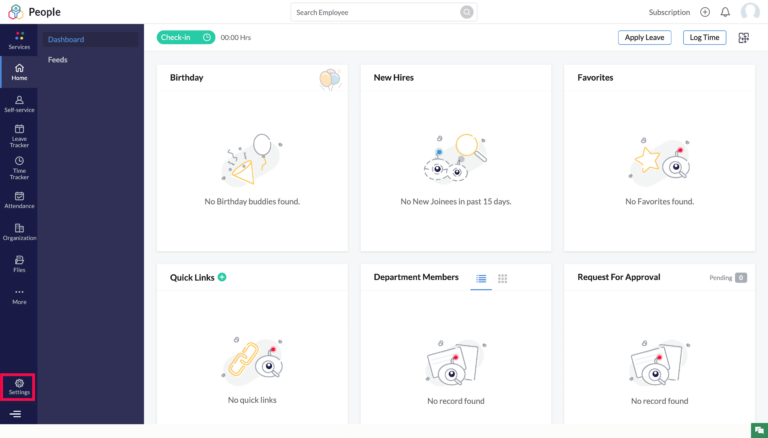
Key Features
- Employee Database Management: Centralized system to store and manage employee records, including personal and professional information.
- Leave and Attendance Management: Tracks employee attendance, leave requests, approvals, and balances with customizable policies.
- Performance Management: Facilitates goal-setting, 360-degree feedback, and performance appraisals with a user-friendly interface.
- Time Tracking: Tracks employee work hours and project timesheets, with integration for billing and payroll.
- Employee Self-Service: Employees can update personal details, apply for leaves, view attendance, and access their payslips through a self-service portal.
- HR Workflows Automation: Automates HR processes like onboarding, approvals, document management, and performance reviews.
- Customizable Forms: Allows creating custom forms to gather data or requests, which can be used for surveys, feedback, and more.
- Mobile App: Employees and managers can access HR functionalities like leave requests, timesheets, and approvals on the go via the mobile app.
- HR Analytics and Reporting: Provides insights into employee data through customizable reports and dashboards for better decision-making.
- Integration with Other Zoho Apps: Seamlessly integrates with other Zoho products like Zoho Payroll, Zoho Expense, and third-party apps.
Workflow
HR Dashboard
$1 to $4 per employee per month • Trial: Yes • Free Plan: Yes.
Pros
Affordable Pricing: Offers a cost-effective HR solution with flexible pricing plans suitable for small and medium-sized businesses.
Easy to Use: Intuitive interface and easy navigation make it accessible for HR teams and employees alike.
Customizability: Highly customizable workflows, forms, and modules to adapt to the unique needs of businesses.
Comprehensive HR Suite: Covers most HR tasks, including attendance, performance management, and time tracking in a single platform.
Mobile Accessibility: The mobile app provides flexibility and convenience for users to manage tasks on the go.
Seamless Integration: Integrates with other Zoho apps and external tools, providing a connected ecosystem for businesses.
Automation Capabilities: Automates repetitive HR processes, saving time and reducing manual efforts.
Employee Self-Service: Empowers employees to manage their own profiles, leave requests, and time tracking, reducing the burden on HR teams.
Cons
Limited Advanced Features: While it covers essential HR tasks, it may lack more advanced features required by large enterprises.
Reporting Complexity: Some users report that customizing reports and analytics can be a bit complex or limited in flexibility.
Customer Support: Support response times and quality can vary, and some users have experienced slow resolutions to issues.
Learning Curve for Customization: Although it offers a lot of customization, setting up complex workflows or configurations may require some technical knowledge.
Mobile App Limitations: While functional, the mobile app has fewer features compared to the desktop version, which might limit certain tasks.
Integration Setup: Initial setup and integration with third-party tools can sometimes be challenging, requiring technical assistance.
Deputy
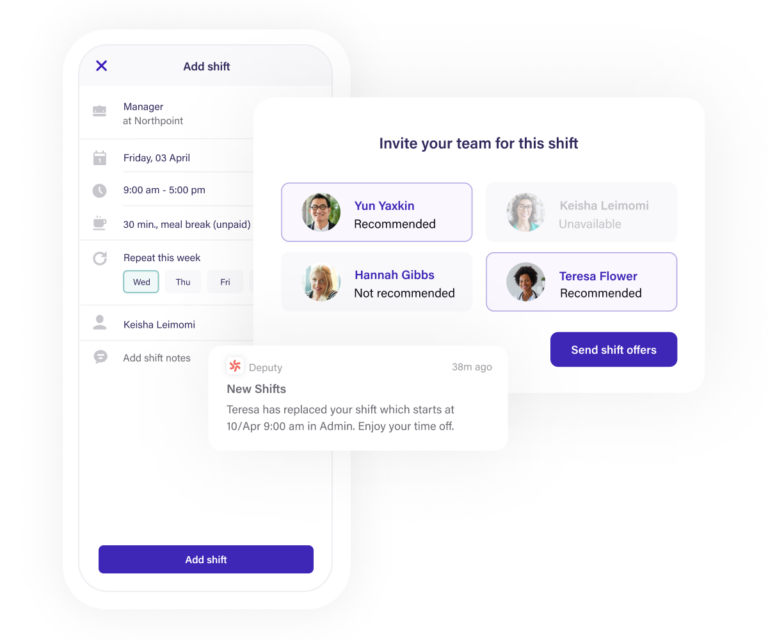
Key Features
- Employee Scheduling: Deputy allows managers to create, manage, and update employee schedules easily using a drag-and-drop interface, with options for recurring shifts and templates.
- Time & Attendance Tracking: Employees can clock in and out using the app, with options for biometric (face recognition) and GPS-based attendance tracking.
- Shift Planning & Management: Shift swapping, availability management, and shift notifications are supported, enabling flexibility for employees and ease of management for employers.
- Payroll Integration: Deputy integrates with payroll systems like Xero, ADP, and QuickBooks, automating payroll data collection from employee attendance and timesheets.
- Task Management: Managers can assign tasks to employees, track completion, and set deadlines through the app, improving operational efficiency.
- Mobile Access: The mobile app allows employees to manage their schedules, submit time-off requests, and communicate with team members. Managers can also approve shifts and track attendance on the go.
- Compliance Management: Ensures scheduling complies with local labor laws, including break rules, overtime, and other regulations.
- Workplace Communication: A built-in communication tool allows for messaging and updates, keeping teams connected and informed.
- Demand Forecasting: Helps businesses predict staffing needs based on historical data, ensuring optimal staff coverage without overstaffing.
- Reports & Analytics: Detailed reporting and analytics tools for managers to track labor costs, attendance, and productivity in real time.
$3.50 to $4.90 per employee per month • Trial: Yes • Free Plan: Yes.
Pros
Easy Scheduling: The drag-and-drop schedule builder makes creating and managing employee shifts very simple and efficient.
Automated Time Tracking: Features like GPS tracking and facial recognition reduce the risk of time theft and ensure accurate attendance records.
Integrations with Payroll: Seamless integration with popular payroll software, reducing manual entry and the chance for errors.
Mobile-Friendly: Employees can manage schedules, request time off, and track shifts from their smartphones, enhancing flexibility.
Real-Time Notifications: Both managers and employees get real-time notifications about shift changes, open shifts, and upcoming tasks, improving communication.
Labor Law Compliance: Deputy helps ensure compliance with local labor laws, saving businesses from potential legal issues.
Cost-Effective for Small Businesses: Deputy is affordable and provides excellent value, especially for small to medium-sized businesses needing efficient scheduling.
Shift Swapping & Flexibility: Employees can swap shifts with ease, reducing managerial involvement in minor shift changes.
Demand Forecasting: Accurate forecasting tools help businesses optimize staff levels and control labor costs.
Cons
Limited Advanced Features: For large businesses with complex operations, Deputy might lack some advanced HR, project management, or payroll features that bigger platforms offer.
Learning Curve for New Users: While intuitive, some features may have a learning curve for first-time users, especially when managing a large number of employees.
Lack of Customization: Some users may find limitations in customizing reports and specific workflows.
Mobile App Bugs: Some users have reported occasional bugs or performance issues with the mobile app, though these are typically resolved with updates.
Limited Task Management: The task management feature is basic and may not be sufficient for businesses needing comprehensive task-tracking tools.
Over-Reliance on Internet Connection: Deputy is cloud-based, so it requires a stable internet connection. If internet access is interrupted, it can disrupt time tracking and scheduling.
Cost for Larger Teams: While affordable for small businesses, the cost can rise for larger teams, as it charges per user per month.